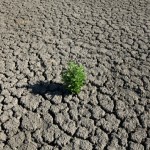The Drought Killed Texas Trees, But Not How You Might Think

Photo by Flickr user GrungeTextures/Creative Commons
The Texas drought has killed an estimated 5.6 million urban trees and 500 million forest trees, roughly 10 percent of the trees in Texas.
The numbers of trees estimated to have been lost to last year’s drought were, in a word, troubling. Up to ten percent of Texas’ urban trees were thought to be lost, a total of up to five million. In the forests the situation was the same, with up to ten percent — 500 million — of Texas’ trees estimated to be lost.
But the drought may not be entirely to blame, according to a new report by the Agrlifie Extension Service at Texas A&M University.
“Drought is the primary contributor to tree kill, but it may not be exactly the way you might be thinking,” Dr. Eric Taylor, Texas AgriLife Extension Service forestry specialist, Overton, says in the report. “You may find this hard to believe, but relatively few trees likely died directly from dehydration in 2011. Instead, the 2011 drought severely weakened mature trees, making them susceptible to opportunistic pathogens like hypoxylon canker and insects like pine bark engraver beetles.”
As the extreme heat and drought of stressed-out older trees, they stood less of a chance against the opposition. “Just like humans, a healthy organism is able to fight off the problems that are trying to come in and attack them,” says Jim Hauser, a Forest Health Coordinator with the Texas Forest Service.
The report says that in most cases, the trees lost to the drought “were already stressed from a number of pre-existing environmental factors such as overcrowding, growing on the wrong site, age, soil compaction, trenching or inappropriate use of herbicides. If not for these factors, a large proportion of the trees that died might have recovered from the drought.”
So what can you do? Hauser of the Forest Service says that at least in residential situations, be a good steward. “Especially for the trees, people have to take care of their trees,” he says. “You can re-plant grass, you can re-plant shrubs, but you can’t do anything when you start to lose the big trees around your house. It’s really heartbreaking.”
The Agrilife Extension Service recommends supplemental watering for your trees if it hasn’t rained in ten days. “Begin sooner if it’s extremely hot and humidity is low,” Taylor says in the report. He recommends using either a trickle or water from a hose or a soaker hose, and to water right right outside the “drip line,” i.e. the border formed by the furthest branches of the tree. And it’s best to water during the evening at night.
You can read more from the report at Texas Agrilife Today.

